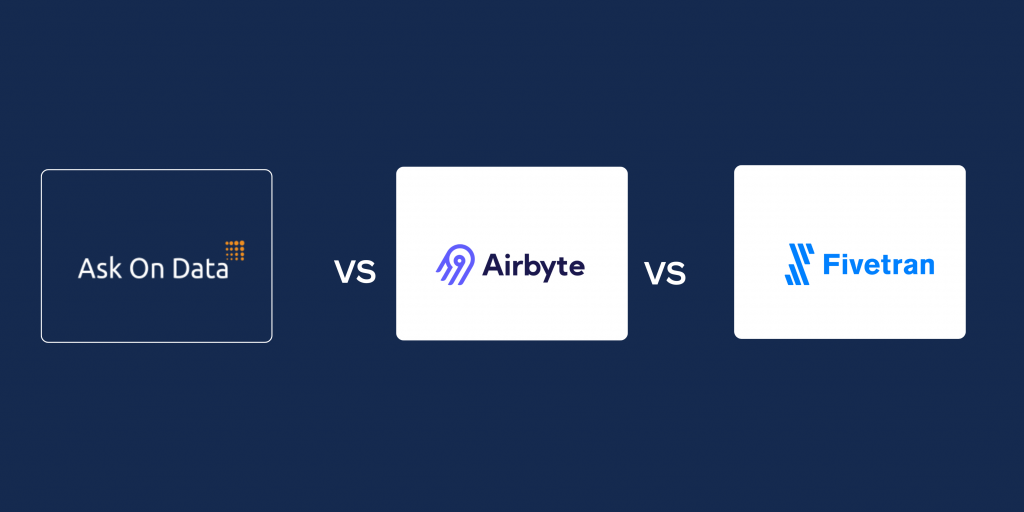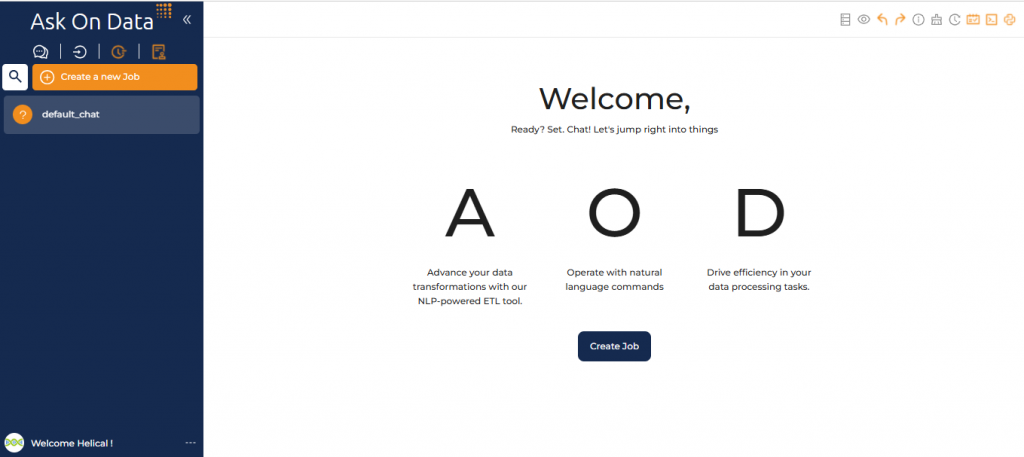
In the ever-expanding world of data engineering, teams are constantly searching for the right tools to simplify data integration, transformation, and loading processes. Tools like Airbyte and Fivetran have become popular choices, but a new contender — Ask On Data — is reshaping how teams think about ETL and ELT.
This blog dives deep into the Ask On Data vs Airbyte vs Fivetran comparison, exploring which tool best fits modern data needs, how each handles real-world challenges, and why Ask On Data’s AI-powered chat-based approach could be the future of data engineering.
Build and automate data pipelines with a simple chat — no code, no delays.
The Rise of Modern Data Engineering Tools
As organizations generate massive volumes of structured and unstructured data, integrating multiple data sources into a single analytics environment has become essential. Traditional ETL tools require high technical skills, coding, and complex setups — slowing down data operations.
Modern tools like Fivetran, Airbyte, and Ask On Data aim to change that by automating ingestion, transformation, and load processes — but each takes a different approach:
- Fivetran: Focuses on fully managed, plug-and-play connectors.
- Airbyte: Provides an open-source, customizable platform for developers.
- Ask On Data: Brings an AI-driven, chat-based data engineering experience, democratizing access to data integration for everyone — not just engineers.
Overview of the Three Tools
1. Ask On Data – Chat-Based NLP ETL
Ask On Data is an AI-powered data engineering platform that lets users create, transform, and load data pipelines using natural language. Instead of writing code, users can simply type queries like:
“Load customer data from MySQL, join with sales data, and export it to Snowflake.”

Ask On Data instantly generates and executes the required transformations — reducing development time and complexity.
Key Highlights of Ask On Data:
- Chat-based interface with no coding required.
- Real-time preview of data transformations.
- Undo history to revert pipeline changes.
- Integration with databases, APIs, flat files, and data lakes.
- Open-source and managed cloud deployment options.
- Up to 80% cost savings compared to traditional tools.
Ask On Data empowers business analysts, BI developers, and data engineers alike — eliminating the dependency bottleneck between teams.
Build and automate data pipelines with a simple chat — no code, no delays.
2. Airbyte – Open Source ELT Framework
Airbyte is a popular open-source ELT tool that allows data teams to connect, replicate, and sync data from multiple sources to various destinations. It’s favored by engineering teams who want full control and customization over their pipelines.
Key Highlights of Airbyte:
- 600+ prebuilt connectors with community contributions.
- Open-source and self-hosted options.
- Supports incremental and full data syncs.
- Requires technical setup and configuration.
- Great for engineering teams who prefer flexibility.
While Airbyte gives developers strong control, it comes with a higher setup and maintenance cost, making it less accessible for non-technical users.
3. Fivetran – Managed Data Integration Platform
Fivetran is a fully managed SaaS data integration platform focused on simplicity and automation. It handles schema mapping, transformations, and updates without requiring code, but is closed-source and paid.
Key Highlights of Fivetran:
- 500+ connectors covering SaaS, databases, and analytics tools.
- Fully managed, low-maintenance platform.
- Great user interface and automated schema updates.
- High reliability but limited flexibility.
- Pricing based on monthly active rows (can be costly for scale).
Fivetran is ideal for enterprises that want quick, stable integration and are willing to pay for convenience.
Detailed Comparison: Ask On Data vs Airbyte vs Fivetran
| Feature | Ask On Data | Airbyte | Fivetran |
|---|---|---|---|
| Interface & Usability | Chat-based, NLP interface — no code needed | Developer-oriented UI & CLI | No-code, fully managed UI |
| Setup Time | Minutes – conversational setup | Requires manual configuration | Plug-and-play |
| Open Source Availability | ✅ Yes | ✅ Yes | ❌ No |
| Cloud / Self-Hosted | Both options | Both options | Cloud only |
| Customization | High – supports SQL, Python, YAML when needed | Very high (open-source connectors) | Low (closed ecosystem) |
| Learning Curve | Easiest – chat-based | Moderate to high | Easy |
| Target Users | Analysts, BI Developers, Data Engineers | Data Engineers, Developers | Enterprise IT Teams |
| Data Sources Supported | Databases, APIs, Files, Data Lakes | 600+ connectors | 500+ connectors |
| Pricing | Open source + affordable enterprise plans | Free (self-host) / Paid (cloud) | Expensive, usage-based |
| Unique Advantage | AI-powered chat interface for ETL | Open-source flexibility | Fully managed automation |
| Documentation | Built-in pipeline documentation | Technical docs & GitHub | Detailed enterprise documentation |
| Undo / Version History | ✅ Yes | ❌ No | ❌ No |
| Transformation Layer | NLP + SQL-based | Code / config-based | SQL-based (limited) |
Why Ask On Data Leads the Next Generation of ETL Tools
1. Conversational Data Engineering
Ask On Data uses Natural Language Processing (NLP) to understand human commands. You don’t need to know SQL, Python, or YAML — simply describe your task, and the tool does the rest.
2. Accelerates Time to Insight
With instant pipeline creation, real-time data preview, and undo features, Ask On Data cuts development time by over 70%. Business teams can act on insights faster than ever before.
3. Reduces Cost and Complexity
Traditional ETL tools charge based on data volume or active rows. Ask On Data’s flat and transparent pricing model makes it more affordable while providing enterprise-grade performance.
4. Open Source + Managed Flexibility
Unlike Fivetran’s closed system, Ask On Data can be self-hosted or deployed in the cloud. This gives businesses full control over their data while keeping costs predictable.
5. Democratizing Data Engineering
Ask On Data bridges the gap between engineers and business users. Analysts can now build their own pipelines without waiting for developer bandwidth — unlocking true data democratization.
When to Choose Each Tool
| Scenario | Best Tool | Reason |
|---|---|---|
| Non-technical users who want to build pipelines easily | Ask On Data | Chat-based interface with no coding |
| Teams wanting open-source control and community connectors | Airbyte | Developer flexibility |
| Enterprises needing a fully managed, hands-off experience | Fivetran | Automated data ingestion |
| Organizations looking to reduce ETL cost | Ask On Data | Open-source + flat pricing |
| Startups with limited engineering bandwidth | Ask On Data | Fast, simple setup |
Ask On Data: The Future of AI-Powered ETL
Ask On Data isn’t just another data engineering tool — it’s a paradigm shift. By combining AI, NLP, and automation, it transforms complex ETL tasks into simple conversations.
With support for databases, APIs, data lakes, and CSVs, Ask On Data helps teams build, transform, and export data faster — without relying heavily on data engineers.
Its undo feature, real-time data preview, and self-hosted option make it a unique hybrid between no-code and full-control tools. Whether you’re a data analyst, BI developer, or data engineer, Ask On Data empowers you to achieve more — faster and cheaper.
Build and automate data pipelines with a simple chat — no code, no delays.
